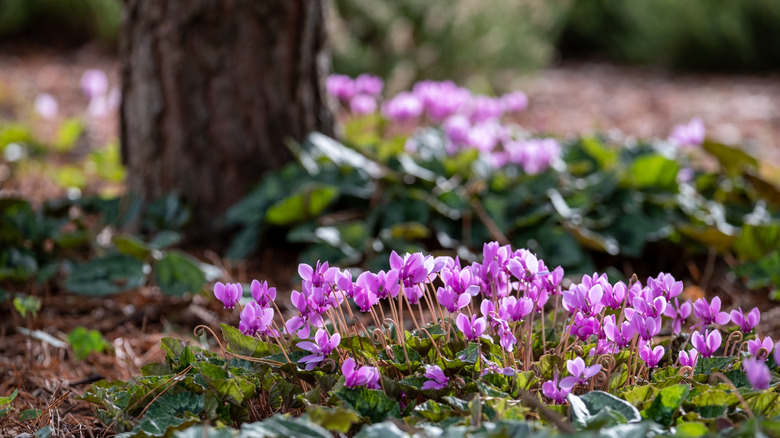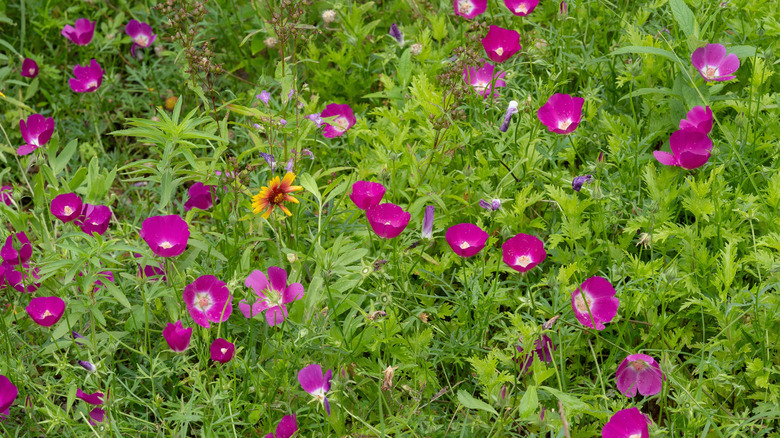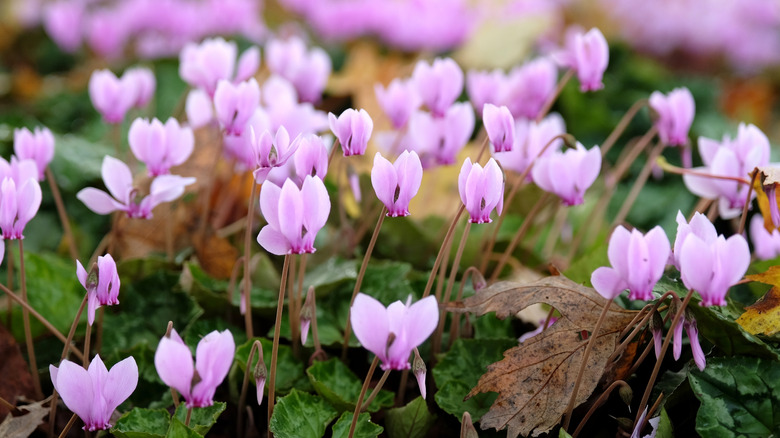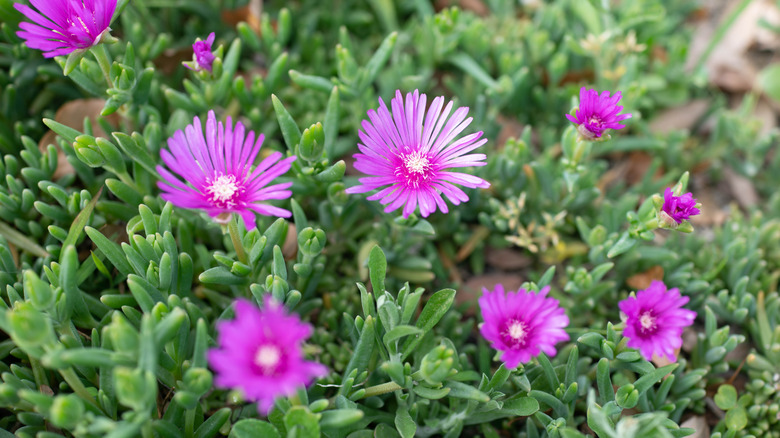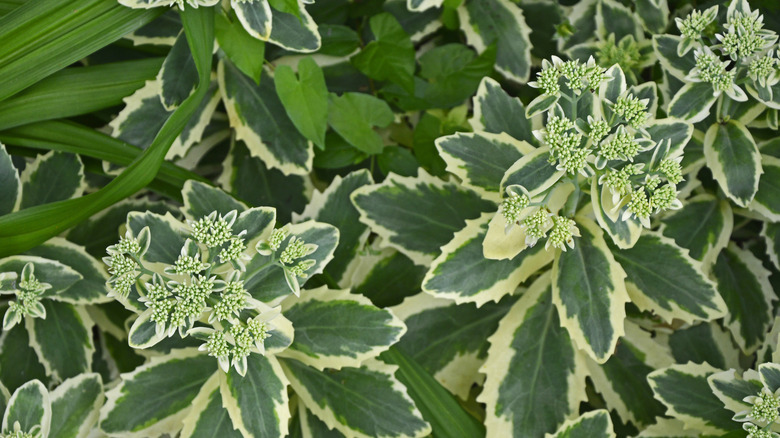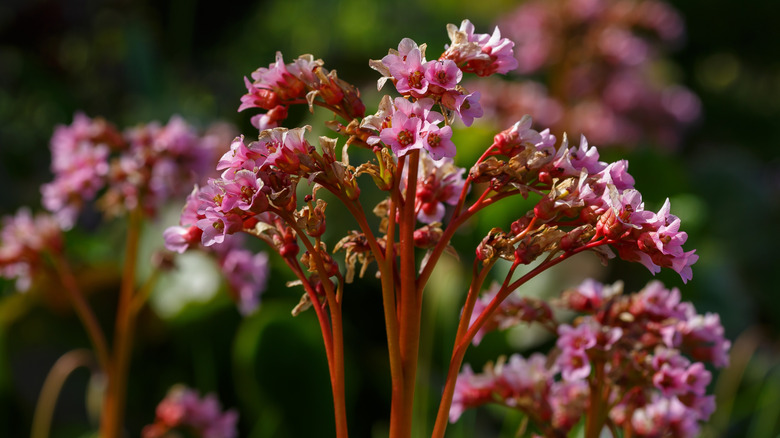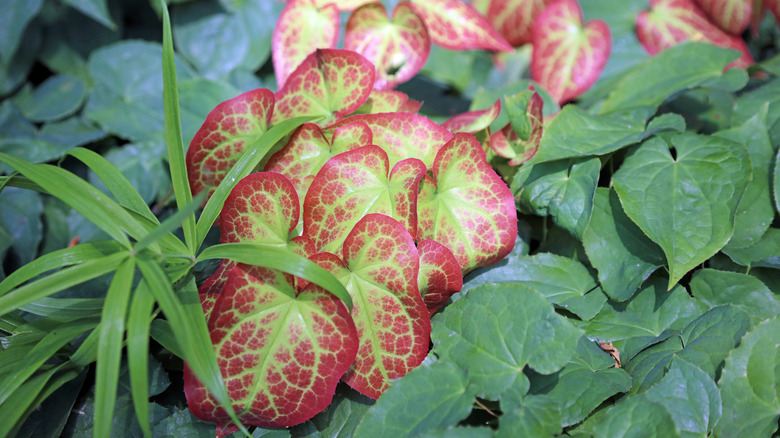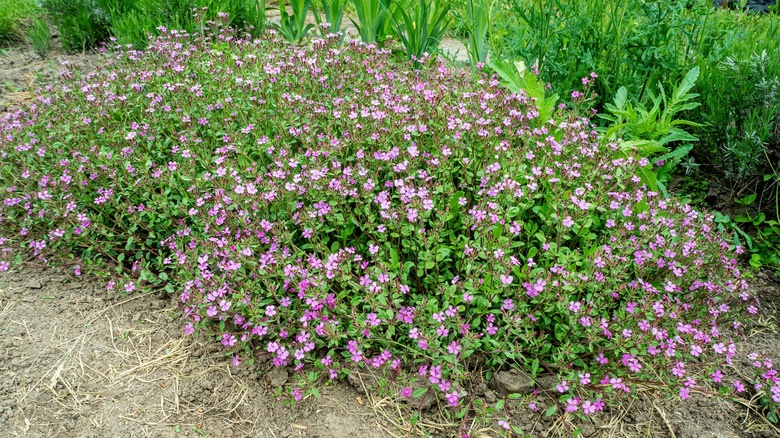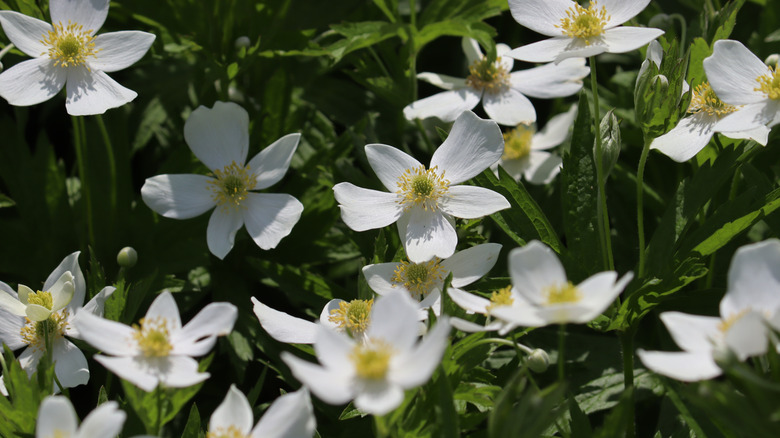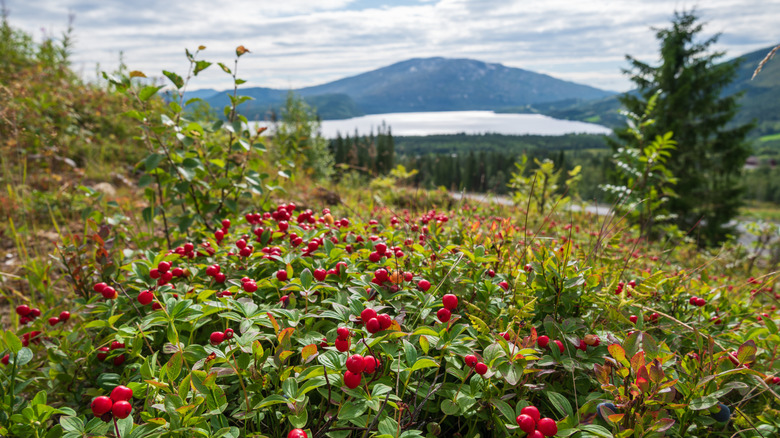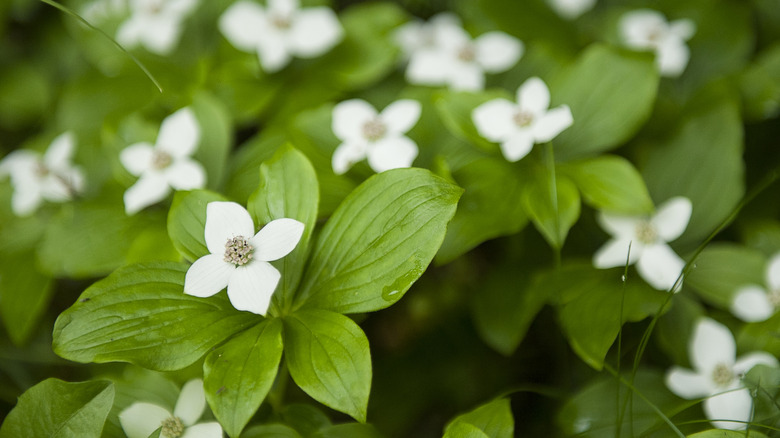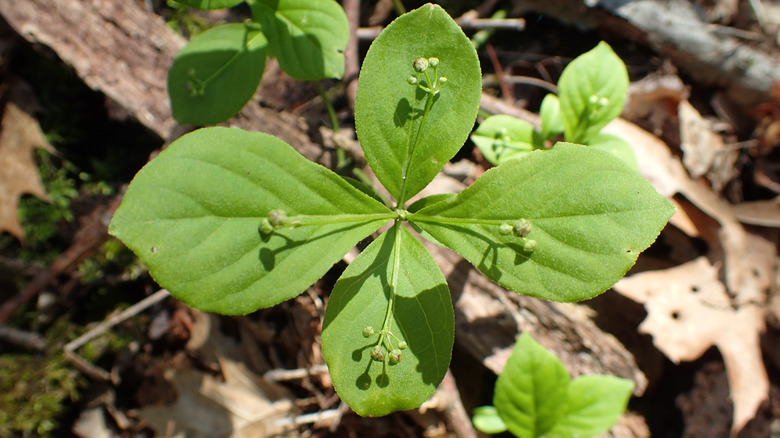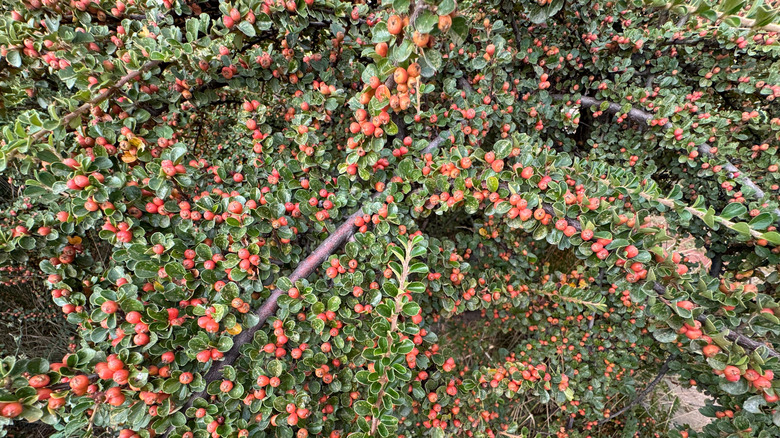14 Ground Covers You Should Plant In Late Summer For Beautiful Fall Color
While they often fade into the background of your gardenscape, ground cover plants are actually a star feature in any yard. These often low-maintenance plants offer several benefits, including blocking out weeds, improving your soil, and providing year-round interest and color. There are also a range of ground cover plants that thrive in full sun and several other ground cover plants that love shade, making them an easy choice for a variety of yards. If you're looking to add some beauty to your backyard for fall, planting a late-summer ground cover is the way to go. From hardy cyclamen to barrenwort, there are many different options to choose from.
When looking for the best late-season ground cover plants for a colorful landscape in the fall, there are a few factors to consider. You will likely want to look for evergreen varieties, especially those that flower later in the season. Also, ground covers with deep, rich colors will help you really lean into the fall vibes and make the most of your autumn garden.
Poppy mallow
Callirhoe involucrata, commonly referred to as poppy mallow, is a tough perennial that can last through the winter in USDA hardiness zones 4 through 9. Short, ground cover versions of the plant serve as an easy way to add a vibrant pop of fuchsia to your autumn garden. Late summer to early fall are among the best times to plant this beautiful perennial from seed, or you can transplant the flowers from pots.
Hardy cyclamen
Cyclamen hederifolium, also known as hardy cyclamen, when planted in late summer, produces gorgeous white-pinkish blooms in the fall. In addition to the flowers themselves, this popular ground cover produces beautiful leaves that stay vibrant straight through winter. The leaves are dark green and feature an almost silver outline. This particular species of cyclamen is suitable for hardiness zones 4a through 9b.
Ice plant
Native to Africa, the ice plant (Delosperma spp.) produces a daisy-like flower and comes in a range of colors, including yellow, orange, purple, and various shades of pink. This lush ground cover is most successful in hardiness zones 5 through 8. Certain species also commonly known as ice plants, such as Carpobrotus edulis, or highway ice plant, are considered invasive, especially in California. Luckily, the Delosperma genus is not invasive and would make a beautiful addition to any fall landscape.
Garden stonecrop
Hylotelephium erythrostictum, which is also known by the common name garden stonecrop, is characterized by its bright green leaves with a white/silver outline. In the fall, this thick ground cover produces small clusters of pink flowers. In northern areas, you can plant garden stonecrop seedlings at the end of summer to enjoy their foliage into the fall season.
Bergenia
Bergenia cordifolia, commonly referred to as just Bergenia or pigsqueak, is a slow-spreading ground cover that produces glossy leaves that transform from green to red. In the spring, they also produce beautiful flowers. The plant is suitable for hardiness zones 3 through 8 and can thrive in full to partial shade. In addition to the shade, this plant enjoys well-draining and moist soil that contains plenty of organic matter.
Barrenwort
Epimedium spp., also known as barrenwort is a wonderful addition to any fall garden. The ground cover's heart-shaped leaves are green when fully mature in the summer and fade to a brilliant red come fall. Ideal for hardiness zones 4 through 8, barrenwort plants typically spread about 12 inches wide. The plant enjoys a well-draining soil and full to partial shade. In the spring, it produces a delicate flower that's usually red, white, or yellow.
Soapwort
Saponaria officinalis (Soapwort) is an ideal ground cover for small areas and works well for bordering garden beds. When in full bloom, which can be anywhere between June and October, the plant produces delicate pink flowers. The plant is best for hardiness zones 2 through 8 and prefers full sun and dry soil. Many natural soap and cleaning products contain soapwort extract. Just keep in mind that this species is considered invasive in certain states, such as California, Indiana, Wisconsin, Oregon, Ohio, and West Virginia, so check with your local municipality before planting it in your yard.
Windflower
Anemone canadensis or windflower is native to North America and produces a small white flower with five petals. While this ground cover typically blooms in the spring, the lush, green foliage remains vibrant throughout the fall season. Suitable for hardiness zones 3 through 8, windflower prefers full to partial sun and medium-wet soil. Gardeners should be careful with the placement of this plant as it can be aggressive, through its spread of underground rhizomes.
Red bearberry
Arctostaphylos uva-ursi also known by its common name red bearberry, is a gorgeous groundcover that produces bell-shaped flowers that turn into bright red berries in the fall. Perfect for adding a brilliant pop of color, this ground cover plant spreads up to 3 feet and is ideal for hardiness zones 3 through 8. The plant will do best with plenty of sun and dry, well draining soil. Additionally, red bearberry attracts all kinds of critters and insects to your yard including songbirds, bees, and other pollinators.
Bunchberry
Cornus canadensis goes by a handful of common names, including bunchberry and dwarf dogwood. Ideal for hardiness zones 2 through 6, this ground cover plant features green, oval-shaped leaves and small white flowers with four petals. It grows less than 1 foot tall and spreads roughly 1 foot wide. Preferring partial shade and medium water, bunchberry is considered a low-maintenance plant. Although the flowers typically bloom in the summer months, the leaves remain vibrant and turn red through the fall
Running strawberry bush
Euonymus obovatus (running strawberry bush) is a fast-growing ground cover ideal for hardiness zones 6 through 9. The plant can grow up to 18 inches tall and features thick foliage that transforms into stunning shades of purple and red in the fall season. Despite the name, the fruit produced by the running strawberry bush can be toxic to humans and should not be ingested.
Rock cotoneaster
If you're looking for another ground cover with brilliant red berries then Cotoneaster horizontalis (rock cotoneaster) is perfect. The ground cover grows in hardiness zones 5 through 7 and enjoys full sun to partial shade with moist, loamy, well-draining soil. The plant features low, horizontal branches with leaves that turn reddish/purple in the fall. Also in the fall, the plant's flowers turn into plump red berries. If you live Oregon, just check with your local municipality to ensure this particular species is not regarded as invasive in your state.
Creeping phlox
Phlox subulata or creeping phlox grows in hardiness zones 3 through 9 and produces dense, mat-like foliage and flowers. The flowers can be pink, white, purple or blue and typically bloom in spring. Some varieties of this ground cover, however, will bloom again in the fall. Even without blossoms, creeping phlox provides a lush green touch to any fall garden.
Hosta 'Golden Tiara'
In general, Hostas are a popular ground cover option as they are a low-maintenance plant. The 'Golden Tiara' variety is ideal for fall as it adds a lovely pop of yellow to your garden beds. It grows in zones 3 through 9, and the heart shaped leaves are green with a yellow margin. In the summer, the plant may produce a purple flower. 'Golden Tiara' spreads fast and is an efficient way to fill gaps in your garden.
